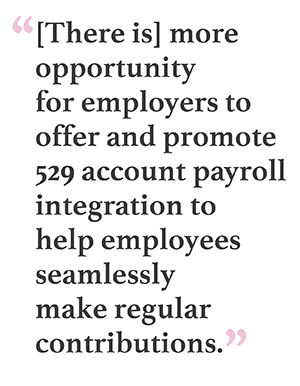 (Image: Shutterstock)
(Image: Shutterstock)
Changing financial and market landscapes are having an impact on individuals' savings strategies, according to new research from independent benefit plan administrator Ascensus. For one thing, as tuition expenses continue to rise, families are increasingly seeing the value of investing in 529 education savings accounts, the company said Tuesday, citing the findings of its annual savings trends research.
Although the market downturn in 2018 had only a "minor impact on overall 529 account balances across all demographics," the average balance reached almost $23,000 as of Dec. 31, Ascensus said in announcing its findings. "Another key trend tied to this landscape of higher education expenses is the entrance of older generations of account owners into the 529 market," it said, noting that account owners ages 55 to 64, and those over 65—with average beneficiary ages of 17 and 13, respectively—had the second- and third-largest average balances of all age groups, both exceeding $22,000.
Saving trends are also being impacted by the fact that healthcare expenses "continue to increase exponentially," Ascensus said, noting the Employee Benefit Research Institute reported that the average couple will now cumulatively need $399,000 to have a 90 percent chance of covering all their healthcare expenses in retirement.
 "Heightened awareness for these staggering costs and the increasing popularity of high-deductible health plans have driven HSA [health savings account] enrollment to new highs," the company said, adding there are now more than 25 million health savings accounts held by U.S. savers, with a combined $53 billion in assets.
"Heightened awareness for these staggering costs and the increasing popularity of high-deductible health plans have driven HSA [health savings account] enrollment to new highs," the company said, adding there are now more than 25 million health savings accounts held by U.S. savers, with a combined $53 billion in assets.
Ascensus' 401(k) platform data, meanwhile, showed that Americans under 25 years old are saving at lower rates than those in older age groups, which "suggests the need for further investigation into the impact of competing financial priorities, including student loan debt," according to the company.
But there was a "notable, positive difference in progress for savers" 25 to 34 years old: Of all retirement savers on the Ascensus platform who said they're "on track" to meet their goals, 20 percent are in that age range, compared with only 3 percent who are under 25, the company pointed out.
"We've seen a shift in the way that individuals across different life stages are saving for themselves and their families," according to David Musto, Ascensus president. "To continue to address the savings deficit millions are facing, our industry needs to focus on offering tools and resources that make it quick, simple, and automatic for savers to track their progress," he said in a statement, adding: "Employers, state governments, and financial advisors will continue to play an integral role in encouraging individuals to make the most of the savings vehicles and tools available to them."
The company analyzed data across a population of more than 88,000 retirement plans, 4.6 million 529 college savings accounts, over 280,000 consumer-directed health care accounts, and 20 Achieving a Better Life Experience (ABLE) plans for which it provided recordkeeping and administrative services as of Dec. 31, it said.
One takeaway from the research was that there's still "no one-size-fits-all approach to planning for what matters most," Ascensus said.
Among the other findings of the research was that plan sponsors and savers see value in automatic savings models: 401(k) plans designed with automatic enrollment and automatic escalation features saw an average plan-weighted participation rate of 81 percent, 10 percentage points higher than that of plans without automatic enrollment, the company said. In 2018, 35 percent of 529 account owners had scheduled recurring bank contributions, and 20 percent of ABLE accounts leveraged automatic savings methods. About 6 percent of 529 account owners use a payroll direct deposit, but there is "more opportunity for employers to offer and promote 529 account payroll integration to help employees seamlessly make regular contributions," it said.
Meanwhile, digital tools are having a positive influence, it said, noting that its Retirement Outlook Tool enables savers to refine retirement savings goals, illustrating how their current savings levels may affect future readiness. In 2018, 26 percent of first-time tool users were saving at an average rate of 8 percent within only a few weeks of engaging with it, the company said. That "suggests that access to the right planning tools can make a positive difference in getting employees closer to a savings rate of 9 percent or more, the minimum rate that 'financially prepared' savers have selected," it said.
From: ThinkAdvisor
© 2025 ALM Global, LLC, All Rights Reserved. Request academic re-use from www.copyright.com. All other uses, submit a request to [email protected]. For more information visit Asset & Logo Licensing.




